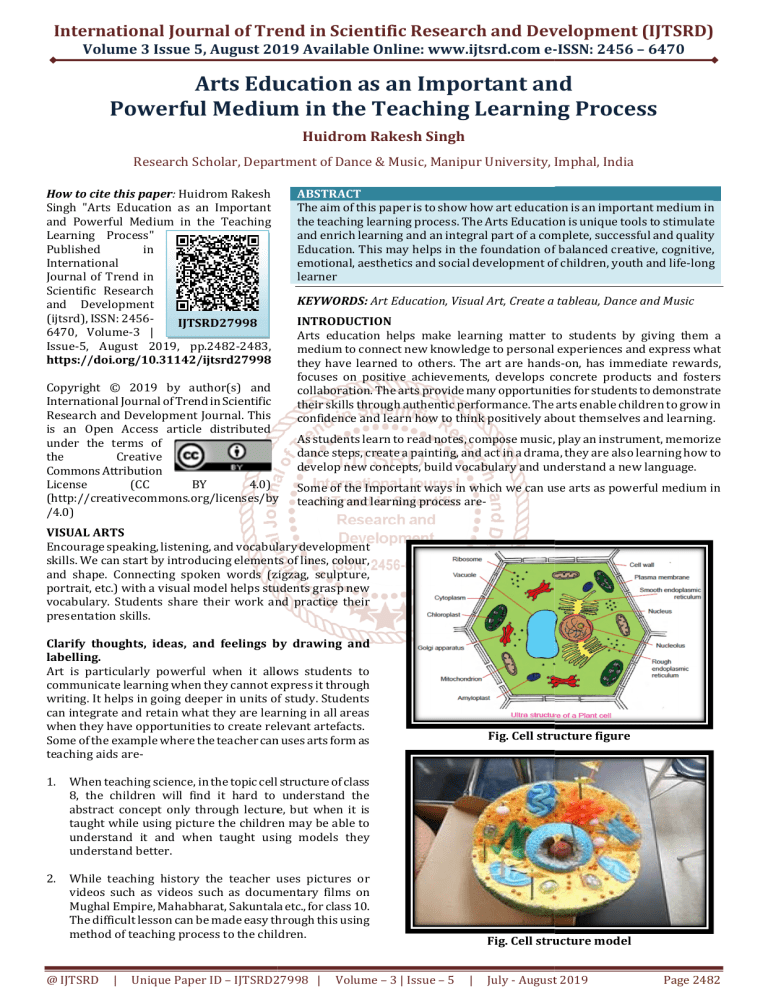
International Journal of Trend in Scientific Research and Development (IJTSRD)
Volume 3 Issue 5, August 2019 Available Online: www.ijtsrd.com e--ISSN: 2456 – 6470
Arts Education as an Important and
Powerful Medium in the
he Teaching Learning Process
Huidrom Rakesh Singh
Research Scholar, Department
artment of Dance & Music, Manipur University, Imphal, India
How to cite this paper: Huidrom Rakesh
Singh "Arts Education as an Important
and Powerful Medium in the Teaching
Learning Process"
Published
in
International
Journal of Trend in
Scientific Research
and Development
(ijtsrd), ISSN: 2456IJTSRD27998
6470, Volume-3 |
Issue-5, August 2019, pp.2482-2483,
https://doi.org/10.31142/ijtsrd27998
Copyright © 2019 by author(s) and
International Journal of Trend in Scientific
Research and Development Journal. This
is an Open Access article distributed
under the terms of
the
Creative
Commons Attribution
License
(CC
BY
4.0)
(http://creativecommons.org/licenses/by
http://creativecommons.org/licenses/by
/4.0)
ABSTRACT
The aim of this paper is to show how art education is an important medium in
the teaching learning process. The Arts Education is unique tools to stimulate
and enrich learning and an integral part of a complete, successful and quality
Education. This may helps in the foundation of balanced creative, cognitive,
emotional, aesthetics and social development of children, youth and life-long
life
learner
KEYWORDS: Art Education, Visual Art, Create a tableau, Dance and Music
INTRODUCTION
Arts education helps make learning matter to students by giving them a
medium to connect new knowledge to personal experiences and express what
they have learned to others. The art are hands-on,
hands
has immediate rewards,
focuses on positive achievements, develops
lops concrete products and fosters
collaboration. The arts provide many opportunities for students to demonstrate
their skills through authentic performance. The arts enable children to grow in
confidence and learn how to think positively about themselves and learning.
As students learn to read notes, compose music, play an instrument, memorize
dance steps, create a painting, and act in a drama, they are also learning how to
develop new concepts, build vocabulary and understand a new language.
Some of the Important ways in which we can use arts as powerful medium in
teaching and learning process are-
VISUAL ARTS
Encourage speaking, listening, and vocabulary development
skills. We can start by introducing elements of llines, colour,
and shape. Connecting spoken words (zigzag, sculpture,
portrait, etc.) with a visual model helps students grasp new
vocabulary. Students share their work and practice their
presentation skills.
Clarify thoughts, ideas, and feelings by drawin
drawing and
labelling.
Art is particularly powerful when it allows students to
communicate learning when they cannot express it through
writing. It helps in going deeper in units of study. Students
can integrate and retain what they are learning in all areas
when
n they have opportunities to create relevant artefacts.
Some of the example where the teacher can uses arts form as
teaching aids are1.
When teaching science, in the topic cell structure of class
8, the children will find it hard to understand the
abstract concept only through lecture, but when it is
taught while using picture the children may be able to
understand it and when taught using models they
understand better.
2.
While teaching history the teacher uses pictures or
videos such as videos such as documentary
mentary films on
Mughal Empire, Mahabharat, Sakuntala etc., for class 10.
The difficult lesson can be made easy through this using
method of teaching process to the children.
@ IJTSRD
|
Unique Paper ID – IJTSRD27998
27998 |
Volume – 3 | Issue – 5
Fig. Cell structure figure
Fig. Cell structure model
|
July - August 2019
Page 2482
International Journal of Trend in Scientific Research and Development (IJTSRD) @ www.ijtsrd.com eISSN: 2456-6470
DRAMA
Encourage role playing. Students are able to better
understand a story, character, or even if they are able to
physically act it out. Listening, speaking, reading, and writing
are part of the process, but all students can participate. For
English learners, use pictures and retell the story orally,
while they act it out physically. Students can work
collaboratively to write their own stories and act them out
for friends.
For example in the "hot seat" to understand character.
Students take on the role of a character (fictional or real) and
sit in the "hot seat," where they answer the questions of a
curious public. Students ask the wolf, "Why did you eat the
little pigs?" They question Ruby Bridges, "Were you scared
when people yelled at you when you walked to school each
day?"
Create a tableau. Even young students can develop a still,
silent performance from a scene in a story or representing
an event in text, developing a fuller understanding about life
and literature. In this way each student is made to
participate and thereby making the class an interactive and
enjoyable one.
DANCE
Little steps as to develop the expressions of dance can be
developed with the students. Focus here is on the
movements of body to reflect the sun’s gentle warmth /rage
of the sun and the students performing the ritual of worship
of sun with graceful movements. Let the students create a
sun dance, using any combination of soft movements, sharp
/ graceful or yogic combinations. Add formations to bring
more motion and placements giving each child to come in
front and demonstrate his talent Create a dance journey
from the moods and emotions of sun to the effect of the sun
on the earth and it’s inhabitants and further to the worship
of the sun and then to a request to Sun God for the strength
from the sun through the yogic exercises of Surya namaskar.
Movement and Freeze: This is a fun and simple way to
incorporate dance movements (skip, twirl, gallop, etc.) as
students learn about historical figures, characters, and
events.
The teacher can organise a dance competition on various
themes such Human Rights Education; to introduce the
Human Rights Declaration to young people in an experiential
way.
@ IJTSRD
|
Unique Paper ID – IJTSRD27998 |
MUSIC, SONG & PERFORMANCE
Sing the concepts. When teacher Want to teach students to
clean up, learn grammar, or grasp math facts, they can sing
for clean-up, to learn grammar, and math facts too. There are
songs for nearly every concept we want to teach. We can
make up a song using a familiar tune, or find one online.
Songs help students learn and retain information, develops
listening skills, and teach tone, beat, and rhythm. Singing
songs and rhymes teaches English learners how language is
constructed and helps with acquisition of English.
One common example is teaching of rhymes in children uses
body movement, gesture and rhythmic sounds. In this way
the students are made to learn the long rhyme in enjoyable
way.
When teacher can modulate their voice or tone in
appropriate time they will be able to handle the classroom
effectively, strong voice teacher have the capacity to handle
class effectively.
CONCLUSION
Even though when children are exposed to various
knowledge at home they learn the best when they are
exposed in classroom. It enhances their interest and make
them learn fast As a teacher of diverse learners and with
special needs, the teacher must understand that we must
provide different pathways for students to demonstrate
what they know: reading, writing, speaking, singing, dancing,
drawing, and other formats. Incorporating the arts helps
ensure that the needs of different types of learners are met.
References
[1] Devi Prasad (1998), Art: The Basis of Education.
National Book Trust, New Delhi.
[2] Jane Sahi & Roshan Sahi, (2008), Learning Through Art,
Ekalavya, Banglore.
[3] Manfred L. Keiler, (1955), art in the Schoolroom,
University of Nebraska Press.
[4] Santidev Ghosh (1978), Music And Dance in
Rabindranath Tagore’s Education Philosophy, sangeet
Natak Academi, New Delhi.
[5] Terence Wooff (1976), Development in Art Teaching,
Open Book London.
Volume – 3 | Issue – 5
|
July - August 2019
Page 2483



